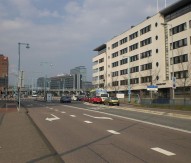

Edward Mitchell
European Synchrotron Radiation Facility
Horizon 2020’s Excellent Science pillar is allocating an estimated €2.5bn to funding investment in the Europe’s research infrastructures. The European Synchrotron Radiation Facility (ESRF), located in Grenoble, France, is a third-generation light source and provides intense X-ray beams to help understand new materials and products through a range of difference sciences and industry sectors. Since its formation in the 1990s, the ESRF has received an estimated €2bn of total investment and currently has 19 funding member states.
The ESRF’s users are split between academics and industrialists, both keen to use the site as a test bed for new materials at the heart of new products. It’s estimated that 6,500 academics visit the ESRF annually through peer review. The ESRF also has strong links with industry worth €2m annually; the research infrastructure has been used by 100 unique clients over the last five years, including Total and L’Oreal. In a recent survey, 40% of ESRF users said they were undertaking research that had application in industry.
Edward Mitchell is head of business development and began by explaining to Horizon2020projects.com the main activities of the ESRF.
Our X-rays are generated from electrons accelerated to close to the speed of light and circulated through an intense magnetic field. When they travel through the field they undulate and as they undulate, the electrons emit intense packets of X-rays resulting in a very fine pencil-like beam of X-rays. We manipulate and monitor those X-rays – it’s a bit like white light. When you put white light through a prism, you get different colours. We carry out an analogical process with X-rays but using crystals instead of a prism to get intense monochromatic X-rays which can be focused down to about 50 nanometres in size.
Those X-rays are used for all different types of science investigations, including fundamental physics, biology, applied chemistry, archaeology, palaeontology and even medicine. We undertake industrial investigations including work in pharmaceuticals, petroleum, polymers, electronics and even frozen foods, for example ice cream. X-rays studies are basically non-destructive and that can be important; you don’t have to destroy a valuable or unique sample to look inside it.
At what stage of research is the synchrotron often used?
We cover all stages of R&D, both academic and industrial, from fundamental science to pre-competitive studies and helping understand industrial operational and process problems. For example, Professor Phil Withers, from the University of Manchester in the UK, does a lot of research on aerospace materials. He uses the ESRF’s high energy X-rays to investigate how metals and composites fatigue and crack which is critical understanding for reliable high-performance aircraft engines. You have turbines turning at very high speeds and they warm up and you need to ensure that the engine components keep their structure; one way of ensuring that is through high-performance alloys. We can study the microstructure of those alloys and understand how they fatigue.
With industry, we work across the full TRL scale from one through to ten; although usually we are at the one to three range in basic principles, pre-competitive and just after pre-competitive R&D. We have also had researchers completing patent work in order to protect themselves or discover whether they are being infringed.
How will ESRF be looking to benefit from Horizon 2020?
I see Horizon 2020 as a very strong opportunity to reinforce the ESRF as a high-performance research infrastructure in Europe and further develop our relationship with industry to the benefit of the so-called ‘Innovation Union’. One of the key barriers we have is that people don’t yet recognise us as being relevant to industry.
We hope to have a more concrete involvement from Europe in providing resources for test cases. We have been very successful in the pharmaceutical industry – about half of our industrial income comes from the sector. We are just starting a project using funding from the French NanoElec programme with both the ESRF and the ILL (our sister neutron source on the Grenoble international site) to help mature and expand opportunities using synchrotron X-rays and neutrons for micro and nano-electronics industrial research. Thanks to this programme, we are just starting to understand the needs of the nano and micro-electronics industry and to develop a mutual understanding bridging the gap between our two worlds. This includes, for example, how to prepare samples suitable for in-operando X-ray and neutron analysis from the real-world samples of industry and how to do this repeatedly under standard conditions to provide the answers that the industry needs. This industry sector is one area in which we wish to improve and it is essential to see money coming forward to help achieve this in other economically important areas like metallurgy, catalysis and chemistry and energy.
Industry is not going to dive in and use the ESRF and invest without having some kind of concrete evidence of impact on their company R&D performance. Part of our challenge is that we have been set up as an academic institution, so our core mission is academic work and we don’t have sufficient capacity to carry out work with industry. When we work with industry, we have to provide a ‘full service’. Academics usually come here as expert communities – they know what they are doing. Industry isn’t positioned to do that and debate whether it is worth making the investment and we need to overcome this barrier.
Europe says it wants to draw together the world of business, industry, academia and research infrastructures, yet if it wants to do that, then we need the funding to catalyse these interactions because it goes beyond our core mission of today – funding for industry training, pilot and feasibility studies, communication and staff dedicated to working with industry. Increasing the role of industry is an important and significant requirement from our public funders and I believe that we can have much more impact than we have today, but you still need the resources to go that extra mile that industry needs.
Working with academia and industry is very different and the oft-held perception of industrial R&D is that it is rather dull and unchallenging. In fact, at the ESRF, the reverse is true; industrial research offers some of our most challenging experiments carried out at the facility, with demanding samples and unconventional problems from exacting clients. Moreover, the expectations and interests of scientists trained in our university systems are changing from a pure ivory tower outlook and it is a noticeable trend that younger scientists are showing more interest and openness towards this challenging science with industry, providing both an opportunity and a foundation for the future.
Edward Mitchell


